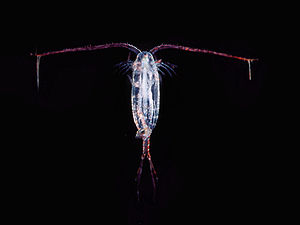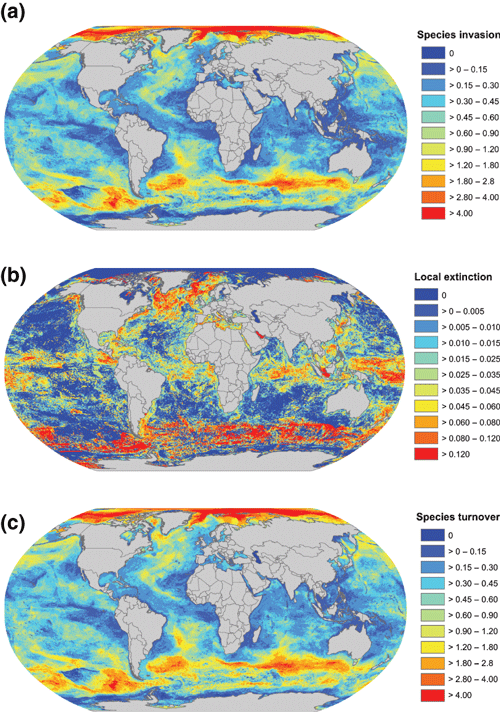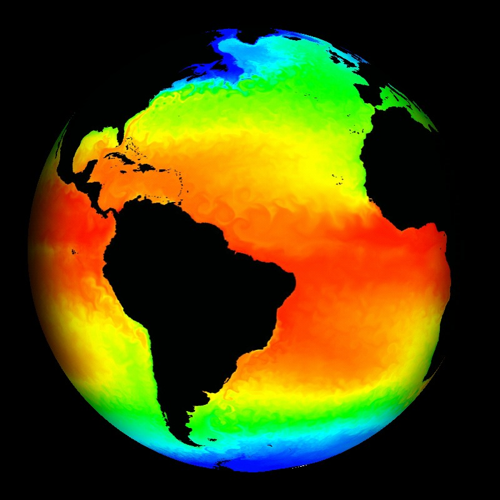Movement is one of the four ways that an organism or an entire species can respond to a change in their environment, which also include
acclimation,
adaptation, and
extinction. Movement refers to the change in an organism's typical habitat as it "searches" for a more hospitable environment in which to eat, live, and reproduce.
Many studies have shown that global climate change has had (and will continue to have) effects on the movement of marine life. In general, scientists expect that organisms, especially
ectotherms, will exhibit movement toward the poles and away from the equator, according to the individual species's
thermal tolerance.
One of the early studies on how climate change impacted marine animals was conducted by
Beaugrand, et al. This study looked at zooplankton, which are thought to provide a reliable way of determining the well being of marine ecosystems in the North Atlantic Ocean and possibly in other regions. There was also a significant amount of data on zooplankton from the
Continuous Plankton Recorder survey. They compared zooplankton and sea surface temperature from the 1960's to data from the 1990's and found an overall poleward movement of warm species and a decrease in the number of subarctic and arctic species. There were some exceptions, but these were attributed to Northern Hemisphere temperature anomalies.

As a result of movement due to climate change, some species' characteristics are changing. In a study by
Perry, et al., marine fishes in the North Sea
that had shifted due to climate change tended to have smaller maximal body length, a younger age at maturity, and a shorter length at maturity than previously recorded in these species.
In a study by Kovach et al., researchers studying the movement of salmon found that the population shifted over time to the majority of fish being "early-migrating" salmon. The researchers state that they found a genetic basis in the phenotypic change. They conclude that natural selection occurred against late-migrating salmon, which could not mate as effectively, and that this change occurred over 2 generations.
In some species, sea surface temperature is an even greater indicator of movement than the location of prey.
Cotton, et al found that, over the long term and a large distance, the movement of basking sharks is more dependent on sea surface temperature than the movement of their zooplankton food source. However, in the short term, their movement is more dependent on zooplankton.
One of the longer studies of the effects of sea surface temperature on populations, which compared current data to data acquired in the 1950's was conducted by
Pitt, et al. In this study, conducted along the Tasmanian coast, 29 different
inter-tidal species were surveyed, of which 55% were found farther south (poleward), and only 3% were found farther north. The average distance that the southern range moved south was 116km, which is about 29km/decade. During this time, sea surface temperatures rose 0.22°C per decade. This study has significant implications based on the rate of movement that was determined. The temperature in the water is expected to go up by 2°C in the next 40 years in this area. With the rate of movement, this may result in the northern range of some species moving southward an additional 176km, which is about the length of Tasmania. After Tasmania, the next island is 1500km away, and no species in this study have been found there.
There has been a great deal of evidence showing a change in distribution of marine fish and invertebrates due to anthropogenic climate change. However, most studies focused on a specific region or specific taxa, so there has been very little data on large scale impacts on a variety of species. This paper by Cheung, et al. attempts to estimate species distribution using a global scale, and examining a large number (1066) of marine species. It predicts that there will be high intensity species invasion moving towards the poles because many species close to the equator are already near their thermal tolerance. The range of species near the poles will shrink because they are also near their thermal tolerance at their lower latitude boundaries. Local extinctions are predicted in the tropics due to migration away from this area, and the impacts of climate change on habitats. Overall, 79-84% of the species are expected to have poleward movement in a range of 223-291km, which is between 45 and 59km per decade.
Determining future movement due to climate change is also important
for conservation efforts and policy. This article focuses on cetaceans and the
effect of global climate change on a model population of dolphins in the
northeast Atlantic Ocean. In order to predict future movement of the species,
the article focused on two models, habitat niche and thermal niche. When
looking only at the habitat model, which focused on water depth, seabed slope,
and standard deviation of seabed slope as the three most important factors, the
suitable habitat reaches much farther north than where dolphins presently live.
However, when you overlay the thermal model, which focused mostly on sea
surface temperature (SST), you end up with a better picture of the current
range. When the models are used with future predictions of SSTs, they show an
northern expansion for the dolphins range because this paper recognizes
dolphins as a warm water limited species. This is important especially for
conservation efforts because current policies that prevent bycatch do not
expand as far north as the predicted range expansion.
Many marine species rely on ocean currents as a method of migration (
S. Nebel), and ocean currents help species spread their larvae and offspring. Recent studies on climate change have suggested that an overall increase in global temperatures may change the North Atlantic ocean current due to the influx of fresh water from the melting of glaciers, which causes a change in ocean water density. Some scientists believe that these temperature increases will cause the North Atlantic ocean current to eventually cease to continue within the next century (
National Geographic). This cessation in water flow from the warmer equatorial waters to the cooler Arctic ones could have a grave effect on the migration patterns of many marine species.
Examples of marine life movement affected by climate change:
- Sea turtles
- Fishes in the North Sea
- Arctic gray whales
- Basking sharks
This article predicts the movement and potential extinction patterns of marine species. It was conducted using observational data from 1066 fish and marine invertebrates and projects their distributional ranges for the year 2050. It was concluded that the most local extinction and species invasion shall occur in the sup-polar regions, the tropics, and semi-enclosed seas. While movement does occur, it is predicted that there will be a loss of 60% of marine biodiversity in the next 40 years.
This graph from the article predicts where movement and extinction will occur :

One of the interesting results from Jon Norberg's research in "Eco-evolutionary responses of biodiversity to climate change" was, contrary to previous thought, high dispersal (movement) among species did not correlate with a lower rate of species extinction. In fact, their results were much the opposite. The researchers found that populations with high dispersal actually had higher rates of extinction, and they attributed these findings to interspecific
competition toward the poles and extinction of rare species. Conversely,
adaptation preserved species when dispersal was low as long as genetic variance was high. This proved to be especially true in colder, more polar regions. This is most likely caused by the fact that the more tropical regions of the ocean have the highest species diversity currently, but they are also the areas that are seeing the largest exodus of species. As species in tropical environments move more pole-ward, species richness in the tropics decreases while richness increases in the pole-ward regions initially. However, as these species invade, the effects of competition and limited resources can be seen as local species become extinct. This is supported by the data represented in the above graph.

Back to
Introduction





Comments
jpwares
Sep 26, 2012
This page is looking great! This is definitely how I envisioned topics expanding and exploding into a really useful resource.